Unraveling the Effect of Synthesis Temperature and Metal Doping on the Structural, Optical, and Photocatalytic Properties of g-C3N4 for Enhanced E. coli Photodisinfection and Self-Cleaning Surface Applications
Abstract
1. Introduction
2. Results and Discussion
2.1. Characterization of g-C3N4 Synthesized at Different Temperatures
2.1.1. Spectroscopic Characterization of Bare g-C3N4
2.1.2. Electrochemical Characterization of Bare g-C3N4
2.2. Photocatalytic Evaluation of Bare g-C3N4 Synthesized at Different Temperatures
2.3. Morphological, Crystallographic, and Spectroscopic Characterization of the Metal-Doped 500 °C g-C3N4 Material
2.4. Evaluation of the Metal Type to Enhance the Photocatalytic Disinfection Performance of the 500 °C g-C3N4 Material
| Material | Power (W) | Initial CFU/mL | Final CFU/mL | Time (h) | References |
|---|---|---|---|---|---|
| Mn/g-C3N4 | 45 | 106 | 0 | 6.0 | This work |
| Co/g-C3N4 | 45 | 106 | 100.5 | 8.0 | This work |
| Cu/g-C3N4 | 45 | 106 | 103 | 6.0 | This work |
| MoS2/g-C3N4 | 100 | 107 | 0 | 0.3 | [24] |
| Ni/g-C3N4 | 24 | 108 | 0 | 2.2 | [25] |
| AgS2/g-C3N4 | 300 | 107 | 0 | 1.5 | [26] |
| MgTiO3/g-C3N4 | 1000 | 107 | 0 | 3.0 | [27] |
| TiO2/g-C3N4 | 300 | 103 | 0 | 0.5 | [28] |
| AgBr/g-C3N4 | 300 | 106.5 | 0 | 1.0 | [29] |
2.5. Evaluation of the Metal Type to Enhance the Photocatalytic Disinfection Performance of the 500 °C g-C3N4 Material in Self-Cleaning Surfaces
3. Materials and Methods
3.1. Reagents
3.2. g-C3N4 Synthesis
3.3. g-C3N4–Metal Composite Synthesis
3.4. Preparation of g-C3N4-Based Self-Cleaning Surfaces
3.5. E. coli Disinfection Tests
3.6. Material Characterization
4. Conclusions
Supplementary Materials
Author Contributions
Funding
Institutional Review Board Statement
Informed Consent Statement
Data Availability Statement
Acknowledgments
Conflicts of Interest
References
- Flemming, H.-C.; Wingender, J.; Szewzyk, U.; Steinberg, P.; Rice, S.A.; Kjelleberg, S. Biofilms: An Emergent Form of Bacterial Life. Nat. Rev. Microbiol. 2016, 14, 563–575. [Google Scholar] [CrossRef]
- Ubaldi, F.; Valeriani, F.; Volpini, V.; Lofrano, G.; Spica, V.R. Antimicrobial Activity of Photocatalytic Coatings on Surfaces: A Systematic Review and Meta-Analysis. Coatings 2024, 14, 92. [Google Scholar] [CrossRef]
- Fujishima, A.; Zhang, X.; Tryk, D.A. TiO2 Photocatalysis and Related Surface Phenomena. Surf. Sci. Rep. 2008, 63, 515–582. [Google Scholar] [CrossRef]
- Xia, D.; Liu, H.; Jiang, Z.; Ng, T.W.; Lai, W.S.; An, T.; Wang, W.; Wong, P.K. Visible-Light-Driven Photocatalytic Inactivation of Escherichia coli K-12 over Thermal Treated Natural Magnetic Sphalerite: Band Structure Analysis and Toxicity Evaluation. Appl. Catal. B 2018, 224, 541–552. [Google Scholar] [CrossRef]
- Rengifo-Herrera, J.A.; Pulgarin, C. Why Five Decades of Massive Research on Heterogeneous Photocatalysis, Especially on TiO2, Has Not yet Driven to Water Disinfection and Detoxification Applications? Critical Review of Drawbacks and Challenges. Chem. Eng. J. 2023, 477, 146875. [Google Scholar] [CrossRef]
- Ong, W.-J.; Tan, L.-L.; Ng, Y.H.; Yong, S.-T.; Chai, S.-P. Graphitic Carbon Nitride (g-C3N4)-Based Photocatalysts for Artificial Photosynthesis and Environmental Remediation: Are We a Step Closer To Achieving Sustainability? Chem. Rev. 2016, 116, 7159–7329. [Google Scholar] [CrossRef]
- Mangiri, R.; Subramanyam, K.; Lee, J.; Lee, M.K.; Lee, C.; Khan, M.S.; Roy, N.; Joo, S.W.; Chung, E. Self-Assembled Flower-like ZnIn2S4 Coupled with g-C3N4@ZIF-67 Heterojunction for Improved Photocatalytic Hydrogen Performance. Surf. Interfaces 2024, 49, 104401. [Google Scholar] [CrossRef]
- Safari, F.; Poursalehi, R.; Delavari, H. Urea-Driven g-C3N4 Nanostructures for Highly Efficient Photoreduction of Cr(vi) under Visible LED Light: Effects of Calcination Temperature. RSC Adv. 2024, 14, 26943–26953. [Google Scholar] [CrossRef] [PubMed]
- Kalidasan, K.; Mallapur, S.; Munirathnam, K.; Nagarajaiah, H.; Reddy, M.B.M.; Kakarla, R.R.; Raghu, A.V. Transition Metals-Doped g-C3N4 Nanostructures as Advanced Photocatalysts for Energy and Environmental Applications. Chemosphere 2024, 352, 141354. [Google Scholar] [CrossRef] [PubMed]
- Zhu, D.; Liu, S.; Chen, M.; Zhang, J.; Wang, X. Flower-like-Flake Fe3O4/g-C3N4 Nanocomposite: Facile Synthesis, Characterization, and Enhanced Photocatalytic Performance. Colloids Surf. A Physicochem. Eng. Asp. 2018, 537, 372–382. [Google Scholar] [CrossRef]
- Zhang, H.; Jia, L.; Wu, P.; Xu, R.; He, J.; Jiang, W. Improved H2O2 Photogeneration by KOH-Doped g-C3N4 under Visible Light Irradiation Due to Synergistic Effect of N Defects and K Modification. Appl. Surf. Sci. 2020, 527, 146584. [Google Scholar] [CrossRef]
- Zhou, Y.; Zhang, L.; Huang, W.; Kong, Q.; Fan, X.; Wang, M.; Shi, J. N-Doped Graphitic Carbon-Incorporated g-C3N4 for Remarkably Enhanced Photocatalytic H2 Evolution under Visible Light. Carbon 2016, 99, 111–117. [Google Scholar] [CrossRef]
- Tauc, J. Optical properties and electronic structure of amorphous Ge and Si. Mater. Res. Bull. 1968, 3, 37–46. [Google Scholar] [CrossRef]
- Maarisetty, D.; Baral, S.S. Defect Engineering in Photocatalysis: Formation, Chemistry, Optoelectronics, and Interface Studies. J. Mater. Chem. A Mater. 2020, 8, 18560–18604. [Google Scholar] [CrossRef]
- Bisquert, J. Theory of the Impedance of Electron Diffusion and Recombination in a Thin Layer. J. Phys. Chem. B 2002, 106, 325–333. [Google Scholar] [CrossRef]
- Xu, L.; Li, L.; Yu, L.; Yu, J.C. Efficient Generation of Singlet Oxygen on Modified G-C3N4 Photocatalyst for Preferential Oxidation of Targeted Organic Pollutants. Chem. Eng. J. 2022, 431, 134241. [Google Scholar] [CrossRef]
- Yue, X.; Yi, S.; Wang, R.; Zhang, Z.; Qiu, S. Cadmium Sulfide and Nickel Synergetic Co-Catalysts Supported on Graphitic Carbon Nitride for Visible-Light-Driven Photocatalytic Hydrogen Evolution. Sci. Rep. 2016, 6, 22268. [Google Scholar] [CrossRef]
- Monje, D.S.; Mercado, D.F.; Ortega-Bedoya, I.C.; Valencia, G.C.; Amaya-Roncancio, S.; Torres-Ceron, D.A.; Vargas, R.; Restrepo-Parra, E.; Torres-Palma, R.A. Addition of Fe3O4 on Carbon Nitride Moves the ROS Formation from HO Radicals to Singlet Oxygen Leading to an Enhanced and Selective Disinfecting Action. ACS Omega, 2025; accepted. [Google Scholar]
- Javed, M.; Khalid, W.B.; Iqbal, S.; Qamar, M.A.; Alrbyawi, H.; Awwad, N.S.; Ibrahium, H.A.; Al-Anazy, M.M.; Elkaeed, E.B.; Pashameah, R.A.; et al. Integration of Mn-ZnFe2O4 with S-g-C3N4 for Boosting Spatial Charge Generation and Separation as an Efficient Photocatalyst. Molecules 2022, 27, 6925. [Google Scholar] [CrossRef]
- Li, A.; Wang, T.; Chang, X.; Cai, W.; Zhang, P.; Zhang, J.; Gong, J. Spatial Separation of Oxidation and Reduction Co-Catalysts for Efficient Charge Separation: Pt@TiO2@MnOx Hollow Spheres for Photocatalytic Reactions. Chem. Sci. 2016, 7, 890–895. [Google Scholar] [CrossRef] [PubMed]
- Zheng, J.; Lim, H.J.; Hedtke, T.; Kim, J.H.; Zhang, S. Manganese oxide for heterogeneous Fenton treatment: Catalyst or inhibitor? Appl. Catal. B 2024, 359, 124531. [Google Scholar] [CrossRef]
- Wang, J.C.; Cui, C.X.; Li, Y.; Liu, L.; Zhang, Y.P.; Shi, W. Porous Mn Doped G-C3N4 Photocatalysts for Enhanced Synergetic Degradation under Visible-Light Illumination. J. Hazard. Mater. 2017, 339, 43–53. [Google Scholar] [CrossRef]
- Waters, L.S.; Sandoval, M.; Storz, G. The Escherichia Coli MntR Miniregulon Includes Genes Encoding a Small Protein and an Efflux Pump Required for Manganese Homeostasis. J. Bacteriol. 2011, 193, 5887–5897. [Google Scholar] [CrossRef]
- Li, P.; Zhai, Y.; Liu, J.; Dai, Y.; Li, D.; Zhang, S. Rapid Inactivation of Bacteria by MoS2/g-C3N4 Nanohybrid Structures Driven by Visible Light. Sci. Rep. 2025, 15, 9266. [Google Scholar] [CrossRef]
- Parasuraman, V.; Sekar, P.P.; Akter, S.M.; Lee, W.R.; Park, T.Y.; Kim, C.G.; Kim, S. Improved Photocatalytic Disinfection of Dual Oxidation State (Dos)-Ni/g–C3N4 under Indoor Daylight. J. Photochem. Photobiol. A Chem. 2023, 434, 114262. [Google Scholar] [CrossRef]
- Zuo, W.; Liang, L.; Ye, F.; Zhao, S. Construction of Visible Light Driven Silver Sulfide/Graphitic Carbon Nitride p-n Heterojunction for Improving Photocatalytic Disinfection. Chemosphere 2021, 283, 131167. [Google Scholar] [CrossRef]
- Jiang, Z.; Wang, B.; Li, Y.; Chan, H.S.; Sun, H.; Wang, T.; Li, H.; Yuan, S.; Leung, M.K.H.; Lu, A.; et al. Solar-Light-Driven Rapid Water Disinfection by Ultrathin Magnesium Titanate/Carbon Nitride Hybrid Photocatalyst: Band Structure Analysis and Role of Reactive Oxygen Species. Appl. Catal. B 2019, 257, 117898. [Google Scholar] [CrossRef]
- Liu, Y.; Zeng, X.; Hu, X.; Hu, J.; Wang, Z.; Yin, Y.; Sun, C.; Zhang, X. Two-Dimensional g-C3N4/TiO2 Nanocomposites as Vertical Z-Scheme Heterojunction for Improved Photocatalytic Water Disinfection. Catal. Today 2019, 335, 243–251. [Google Scholar] [CrossRef]
- Deng, J.; Liang, J.; Li, M.; Tong, M. Enhanced Visible-Light-Driven Photocatalytic Bacteria Disinfection by g-C3N4-AgBr. Colloids Surf. B Biointerfaces 2017, 152, 49–57. [Google Scholar] [CrossRef]
- Shi, Y.; Jiang, S.; Zhou, K.; Bao, C.; Yu, B.; Qian, X.; Wang, B.; Hong, N.; Wen, P.; Gui, Z.; et al. Influence of G-C3N4 Nanosheets on Thermal Stability and Mechanical Properties of Biopolymer Electrolyte Nanocomposite Films: A Novel Investigation. ACS Appl. Mater. Interfaces 2014, 6, 429–437. [Google Scholar] [CrossRef]
- Monje, D.S.; Ruiz, O.S.; Valencia, G.C.; Mercado, D.F. Iron Oxide Nanoparticles Embedded in Organic Microparticles from Yerba Mate Useful for Remediation of Textile Wastewater through a Photo-Fenton Treatment: Ilex Paraguariensis as a Platform of Environmental Interest—Part 1. Environ. Sci. Pollut. Res. 2022, 29, 57127–57146. [Google Scholar] [CrossRef]

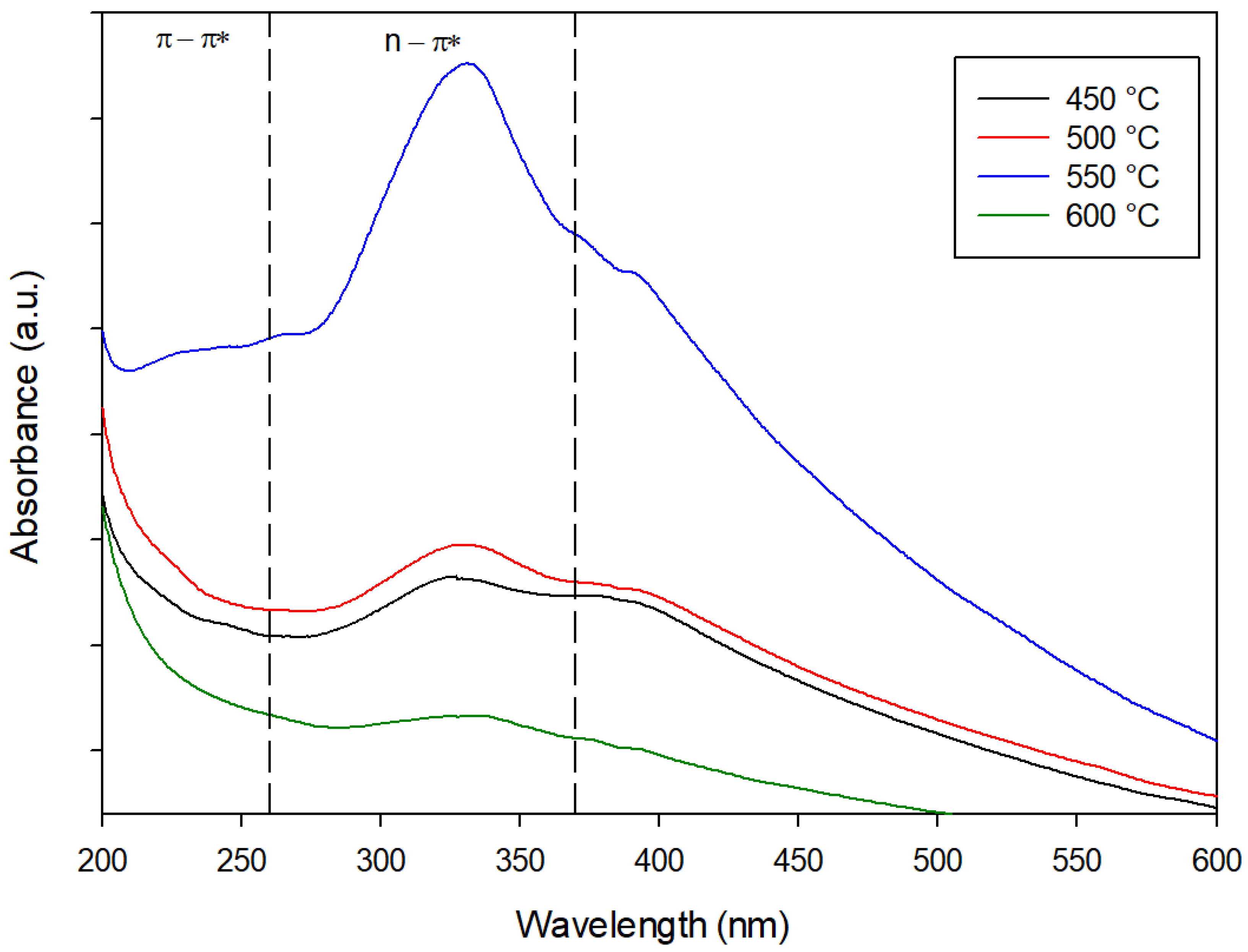

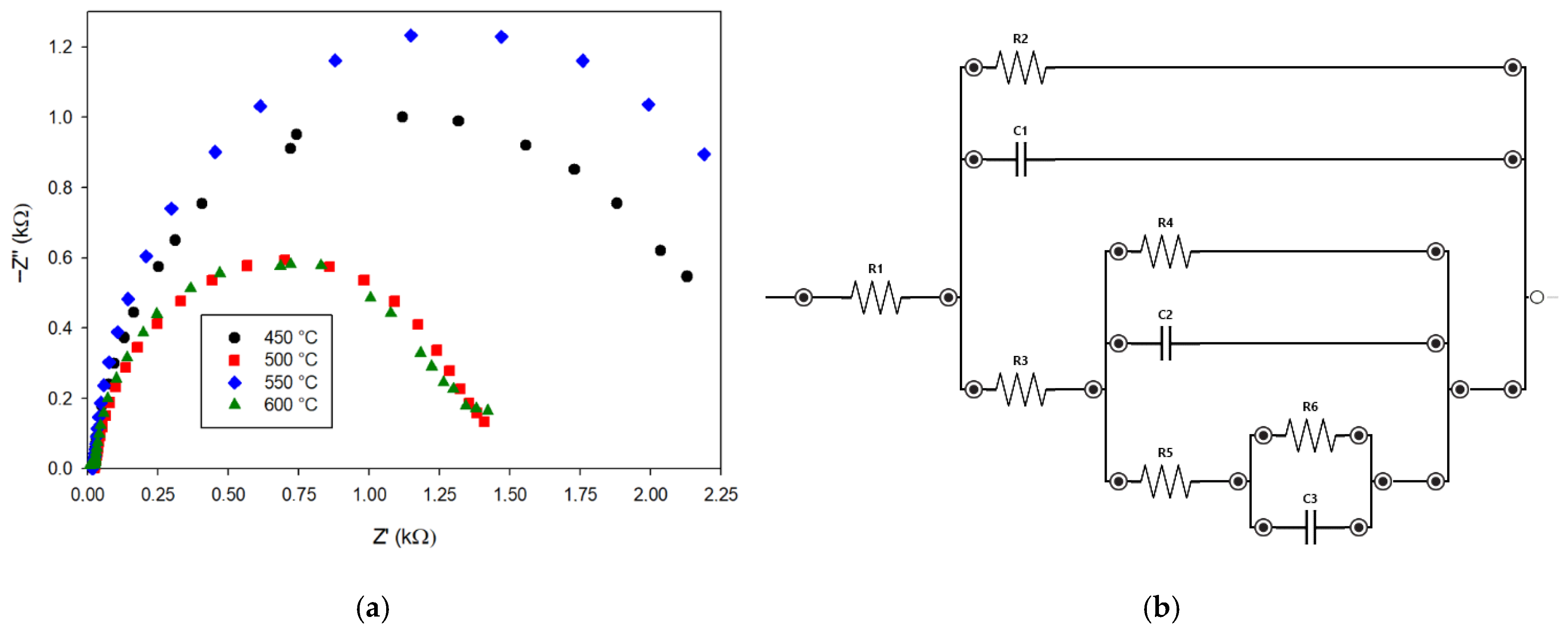

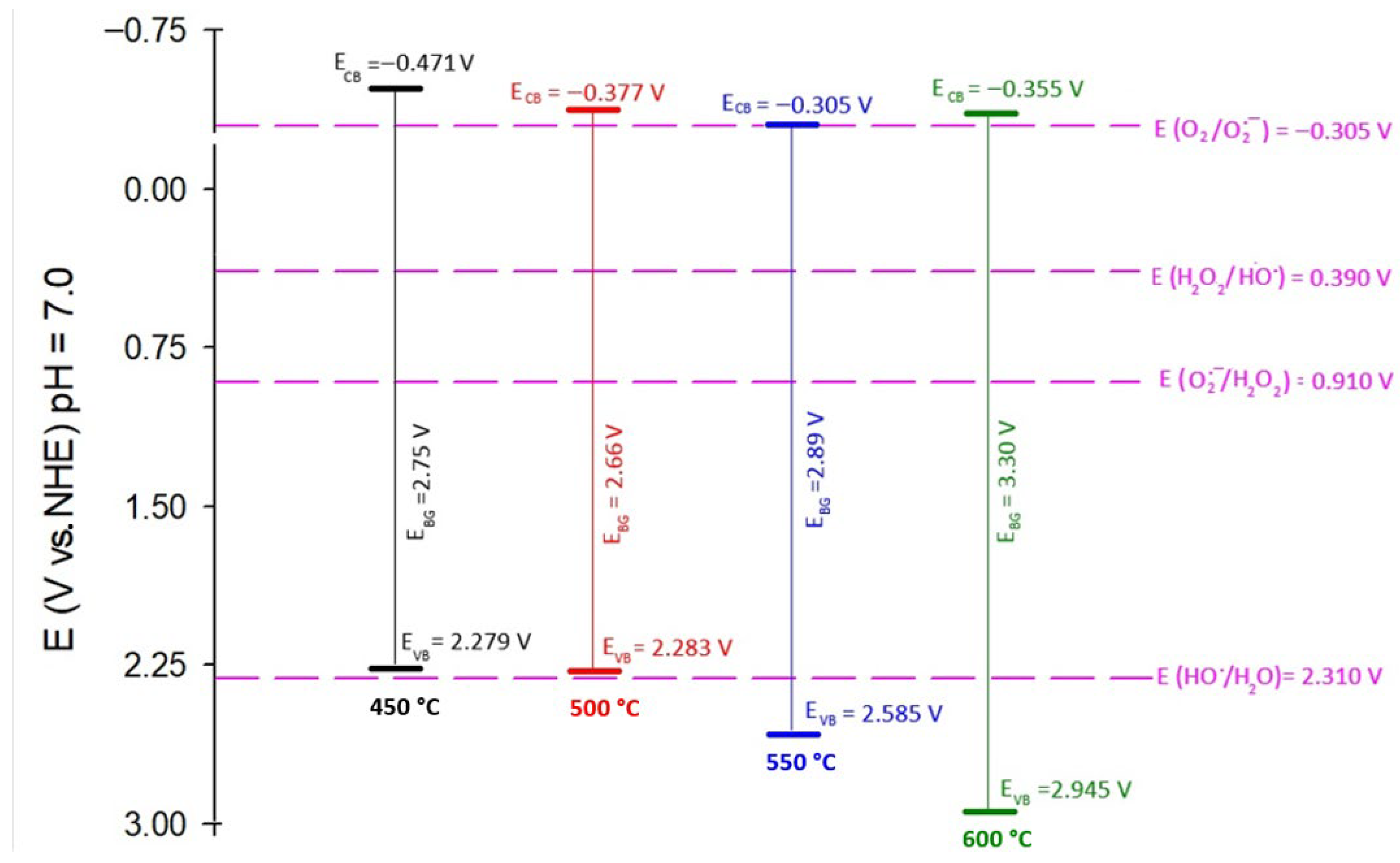

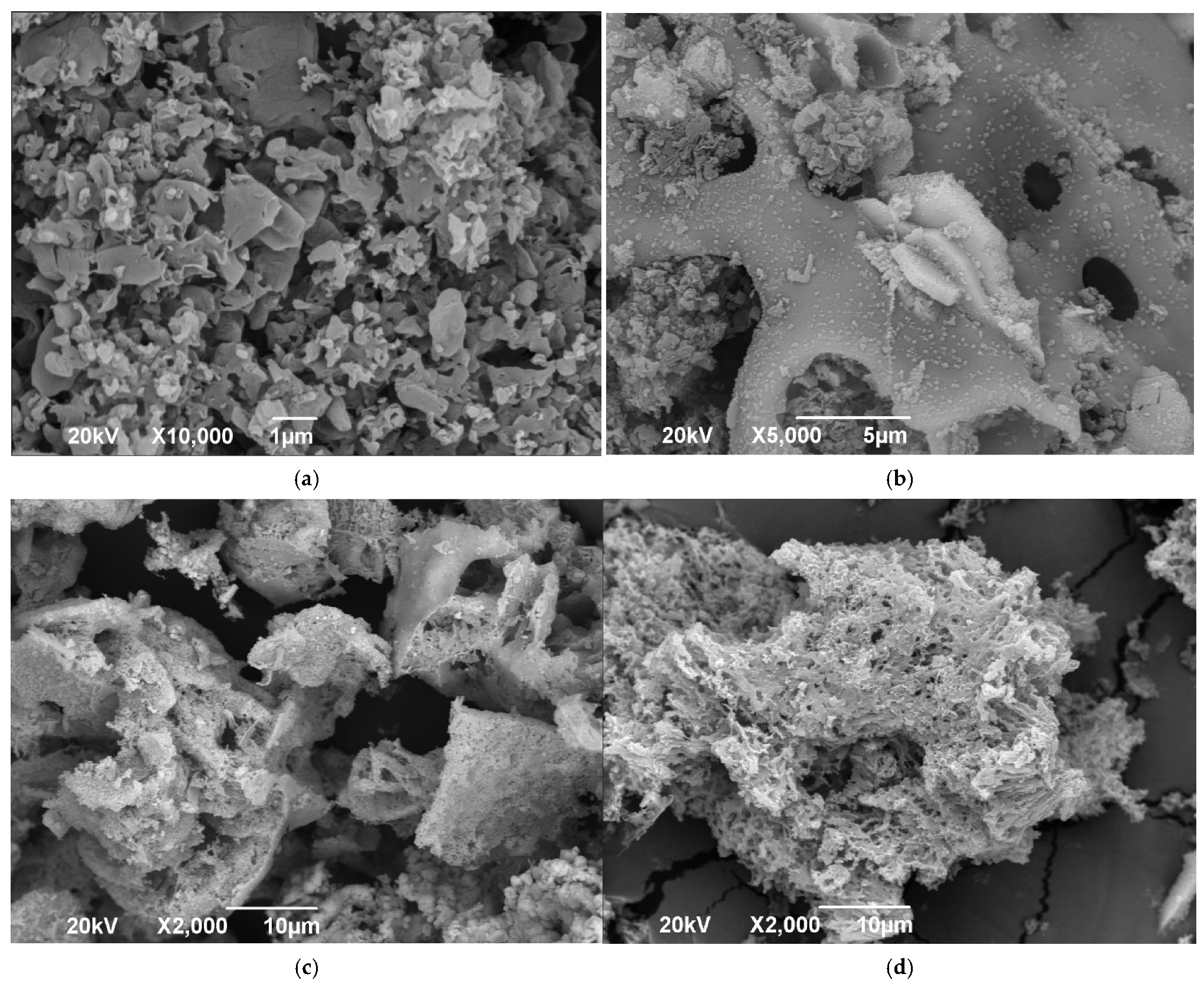

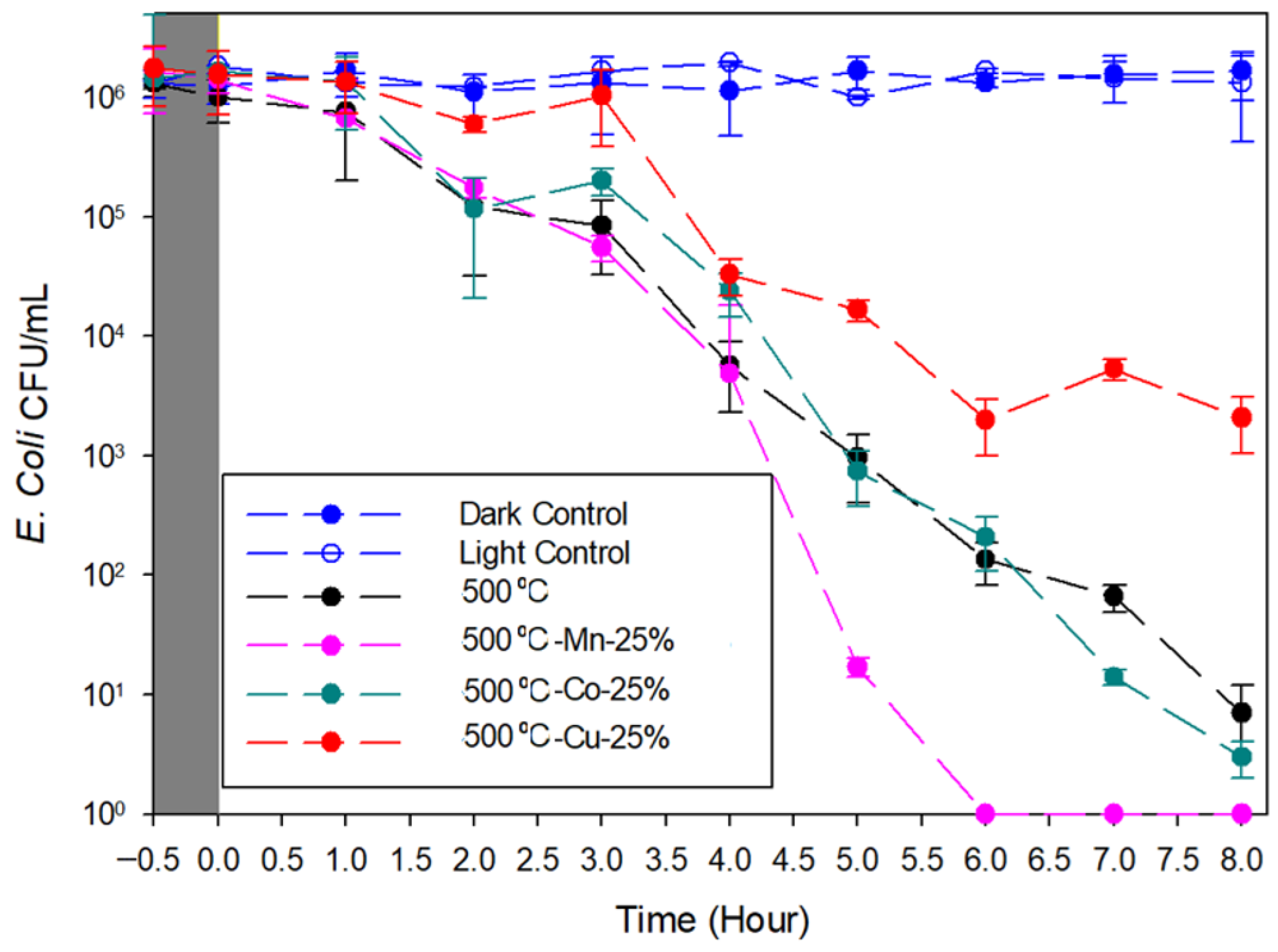


| Material | EBG (eV) | λExc,max (nm) | Electric Resistance (kΩ) | ECB (V) vs. NHE | EVB (V) vs. NHE |
|---|---|---|---|---|---|
| 450 °C | 2.75 | 451 | 1.9 | −0.471 | 2.279 |
| 500 °C | 2.66 | 466 | 1.1 | −0.377 | 2.283 |
| 550 °C | 2.89 | 429 | 2.3 | −0.305 | 2.585 |
| 600 °C | 3.30 | 375 | 1.1 | −0.355 | 2.945 |
Disclaimer/Publisher’s Note: The statements, opinions and data contained in all publications are solely those of the individual author(s) and contributor(s) and not of MDPI and/or the editor(s). MDPI and/or the editor(s) disclaim responsibility for any injury to people or property resulting from any ideas, methods, instructions or products referred to in the content. |
© 2025 by the authors. Licensee MDPI, Basel, Switzerland. This article is an open access article distributed under the terms and conditions of the Creative Commons Attribution (CC BY) license (https://creativecommons.org/licenses/by/4.0/).
Share and Cite
Mercado, D.F.; Ortega Bedoya, I.C.; Valencia, G.C.; Torres-Palma, R.A. Unraveling the Effect of Synthesis Temperature and Metal Doping on the Structural, Optical, and Photocatalytic Properties of g-C3N4 for Enhanced E. coli Photodisinfection and Self-Cleaning Surface Applications. Inorganics 2025, 13, 262. https://doi.org/10.3390/inorganics13080262
Mercado DF, Ortega Bedoya IC, Valencia GC, Torres-Palma RA. Unraveling the Effect of Synthesis Temperature and Metal Doping on the Structural, Optical, and Photocatalytic Properties of g-C3N4 for Enhanced E. coli Photodisinfection and Self-Cleaning Surface Applications. Inorganics. 2025; 13(8):262. https://doi.org/10.3390/inorganics13080262
Chicago/Turabian StyleMercado, D. Fabio, Isabel Cristina Ortega Bedoya, Gloria Cristina Valencia, and Ricardo A. Torres-Palma. 2025. "Unraveling the Effect of Synthesis Temperature and Metal Doping on the Structural, Optical, and Photocatalytic Properties of g-C3N4 for Enhanced E. coli Photodisinfection and Self-Cleaning Surface Applications" Inorganics 13, no. 8: 262. https://doi.org/10.3390/inorganics13080262
APA StyleMercado, D. F., Ortega Bedoya, I. C., Valencia, G. C., & Torres-Palma, R. A. (2025). Unraveling the Effect of Synthesis Temperature and Metal Doping on the Structural, Optical, and Photocatalytic Properties of g-C3N4 for Enhanced E. coli Photodisinfection and Self-Cleaning Surface Applications. Inorganics, 13(8), 262. https://doi.org/10.3390/inorganics13080262







